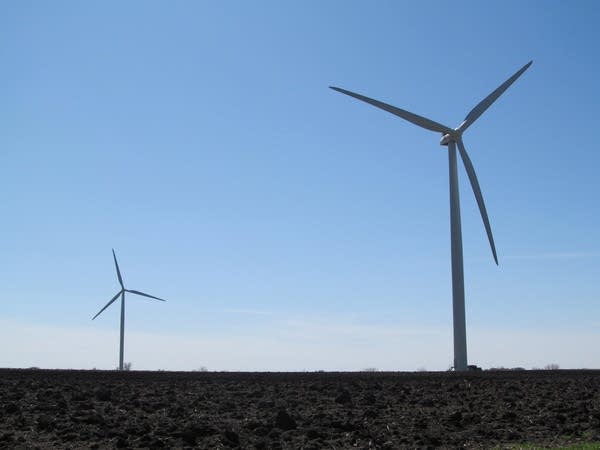Minn. could have to reduce carbon by 40% under new rule

Go Deeper.
Create an account or log in to save stories.
Like this?
Thanks for liking this story! We have added it to a list of your favorite stories.
Despite generating more renewable energy in recent years, Minnesota could need to reduce its carbon dioxide emissions from power plants significantly by 2030 under proposed rules announced Monday by the U.S. Environmental Protection Agency.
State officials were still analyzing the draft rules and said they didn't yet know what the impact would be. But figures released by the EPA show Minnesota would need to reduce its carbon emissions 40 percent by 2030.
• More: EPA seeks to cut power plant carbon by 30%
The EPA said the state's carbon emissions rate was 1,470 lbs/megawatt hour in 2012, and it set an emissions target of 873 lbs/megawatt hour by 2030 — a 40 percent reduction. Nationally, the EPA's goal is to reduce carbon emissions from power plants by 30 percent by 2030 from 2005 levels.
Turn Up Your Support
MPR News helps you turn down the noise and build shared understanding. Turn up your support for this public resource and keep trusted journalism accessible to all.
But the rules are complicated — the EPA issued a 645-page document and hundreds of pages of accompanying materials — and it's possible part of that 40 percent reduction for Minnesota has already been met. In addition, state officials were looking at details such as which of the state's coal-fired power plants were operating in 2012, the base year for some of the EPA's calculations.
"What we're trying to do is turn that [number] into tons of CO2 and then figure out where we are, where we need to be and what that's going to look like," said David Thornton, assistant commissioner for air at the Minnesota Pollution Control Agency.
Minnesota's carbon emissions have fluctuated considerably from year to year as utilities shift between coal and natural gas, depending on market prices for those fuels.
Thornton said utilities have reduced carbon emissions by 12 or 13 percent since 2005. "Some of that has to do with the economic downturn," he said.
The EPA's carbon rules, designed to prevent potential future impacts from climate change, are expected to change the way energy markets work, favoring low-carbon energy options including nuclear, wind and solar. Natural gas also emits less carbon and could replace coal in some power plants. Coal-fired power plants provided nearly half of Minnesota's electricity in 2012, the EPA said.
States are being given flexibility in deciding how to meet the reductions, which are expected to become final next year after states and utilities have a chance to comment. Minnesota's policies requiring renewable energy and conservation could make it easier for the state to reach the proposed reduction, Thornton said. That includes the state's renewable energy standard, which requires utilities to produce a quarter of their electricity from renewable sources by 2025.
"We're well on the way. I don't know how much more we'll have to do as a result of this but I'm sure we'll be able to step up and meet the goal," he said.
State officials in 2016 would need to submit a plan to reach the carbon reduction. Several other states have set up market-based systems for carbon emissions known as cap and trade.
Thornton said state officials will work to identify the most cost effective option to meet the reduction, and that could involve teaming up with other states.
"We are not sure what that means exactly and are interested exploring what the possibilities might be," he said.
UTILITIES REACT
Several of the state's utilities have been touting carbon reductions they have already made since 2005. For example, Xcel Energy officials said they expect to have reduced carbon emissions 30 percent by 2020 from 2005 levels — 10 years ahead of the EPA's national goal.
"I think it shows we're well-prepared to be able to meet this rule and achieve rule outcomes in a way that's cost effective for our customers," said Laura McCarten, an Xcel regional vice president.
Although the regulations were not formally announced until Monday, they have been in the works for a long time.
"It sets a high bar, but Great River Energy has been preparing for just such a rule," said Eric Olsen, Great River Energy's vice president and general counsel.
Last year in an unusual move, the Minnesota Public Utilities Commission urged the utility to rely less on coal. Since 2005, Olsen said Great River Energy has implemented new technology at its coal plants to reduce carbon emissions and is also adding renewable energy to meet future growth in electricity demand.
"We will get full credit for that early action in complying with the rule," he said.
CLEAN ENERGY ADVOCATES PRAISE RULES
Although it isn't yet clear what impact the carbon rules would have on Minnesota, advocates for renewable energy said the sector will see a significant boost.
"Some of the primary options are going to be more zero-carbon technologies like wind and solar, more energy efficiency and perhaps repowering some of the coal plants with natural gas," said J. Drake Hamilton, science policy director for the renewable energy advocacy group Fresh Energy.
Retiring coal plants could also be an option, she said. A coalition of groups want Xcel Energy to retire two if its 1970s-era coal-fired generators at the Sherburne County Generating Station near Becker.
The World Resources Institute, an environmental think tank that analyzed Minnesota's and many other state's energy policies, said the state could extend its renewable energy standard past 2025 to help meet the EPA standards. It could also strengthen its energy efficiency standards, said Michael Obeiter, a World Resources Institute researcher.
"In almost every case, it tends to be the lowest-cost source" for carbon emissions reductions, he said.


